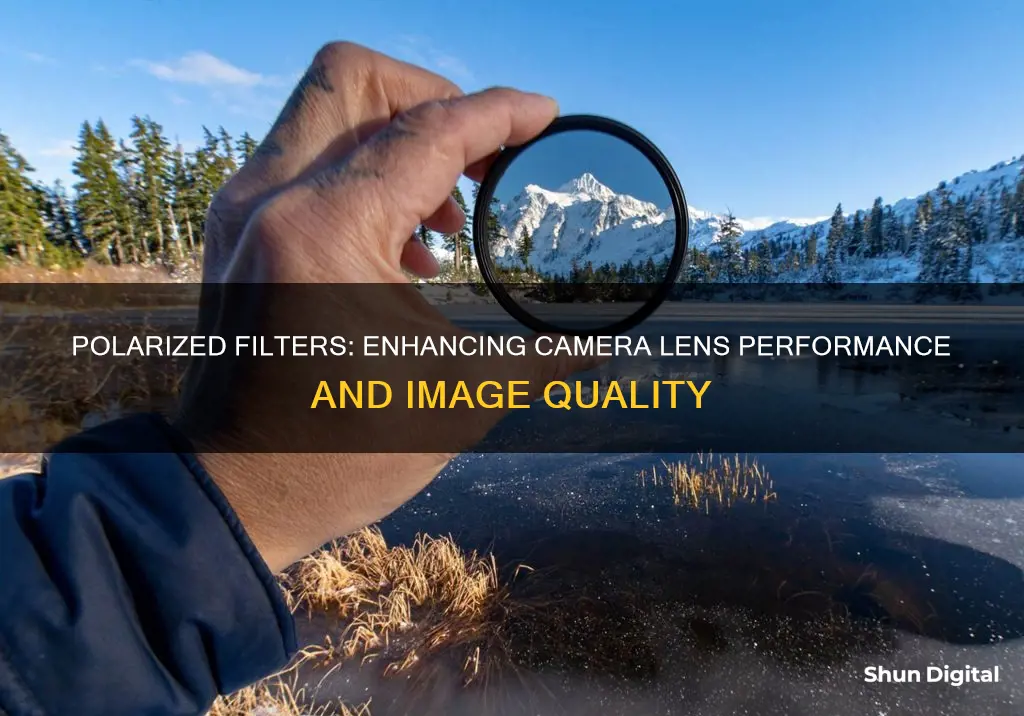
A polarizing filter is a must-have tool for any photographer's kit bag. Placed in front of a camera lens, it reduces haze, reflections, and glare, intensifies blue skies, and increases colour saturation. It's particularly useful for landscape photography, as it can help to cut through haze and improve the vibrancy of colours in nature. It's also handy for cityscape and architectural photography, as it reduces reflections in glass windows and car windshields. However, it's important to note that polarizing filters can reduce the amount of light entering the lens, so they're not ideal for low-light conditions.
| Characteristics | Values |
|---|---|
| Purpose | Darken skies, manage reflections, suppress glare |
| Function | Reduces light waves from passing through, creating a clearer image |
| Use | Placed in front of a camera lens |
| Types | Linear, circular |
| Effect | Increase colour saturation, reduce reflections, reduce haze |
| Disadvantages | Require more time to set up, reduce light entering the lens, expensive |
What You'll Learn

Polarizing filters can reduce reflections and glare from non-metallic surfaces
Polarizing filters are an essential tool for photographers, and one of their key benefits is their ability to reduce reflections and glare from non-metallic surfaces. This is particularly useful when photographing shiny objects or elements like water, but also for a wide range of other subjects, including mountains, rocks, skin, hair, leaves, clouds, and anything wet.
When light bounces off non-metallic surfaces, it becomes polarized, reflecting at the same angle. This results in glare, which can be reduced by using a polarizing filter. The filter separates polarized light moving at a particular angle from non-polarized light, allowing you to manage reflections and reduce glare.
For example, when photographing water, a polarizing filter can cut down on excess brighter light, allowing the colours of the surrounding landscape to come through. Similarly, when shooting through glass, a polarizing filter can help remove reflections that would otherwise distract the viewer.
It's important to note that polarizing filters are less effective on metallic surfaces, as the light reflected off these surfaces is not polarized.
Adapting EF Lenses to Mirrorless Cameras: A Guide
You may want to see also

They can enhance colours by increasing saturation
A polarizing filter can enhance colours by increasing saturation. This is because the filter reduces reflections and haze, allowing the natural colour and detail of the subject to come through.
For example, when taking a photo of foliage, a polarizing filter will render the leaves a brighter shade of green. This is because the filter reduces the reflections from the surface of the leaves, allowing more of the light to be of the diffuse variety, resulting in a more colourful representation.
Similarly, when taking a photo of the sky, a polarizing filter can deepen the blue and improve the contrast between the clouds and the sky. This is because the filter reduces the haze and random light waves in the atmosphere, creating a clearer image.
The effect of a polarizing filter is unique and cannot be replicated in post-processing.
The Wide World Through Wide-Angle Lenses
You may want to see also

They can deepen blue skies
Polarizing filters are a great tool for photographers to deepen blue skies in their images. Blue light waves are shorter than red and green waves, meaning they scatter more easily. By using a polarizing filter, you can prevent randomized blue light from entering your lens, leaving you with the purest blue light possible. This results in deeper, more vibrant blues in your images.
The effect of a polarizing filter is most dramatic when shooting at a 90-degree angle to the sun. This is because the filter's effect is at its greatest when shooting at a right angle to the light source. When the sun is behind you, the polarizing effect will be non-existent. Therefore, it is important to consider the position of the sun when composing your image to make the most of this effect.
It is also worth noting that the polarization effect can vary depending on the time of day and year. This is because the celestial position of the sun affects the degree of polarization that can be obtained from a polarizing filter.
When using a polarizing filter to deepen blue skies, it is important to be mindful of potential issues. For example, using a polarizing filter with a wide-angle lens can result in an unevenly polarized sky, with some areas appearing much darker than others. This is particularly noticeable when shooting at sunrise or sunset when the sun is closer to the horizon. In these situations, it may be helpful to switch to a telephoto lens to focus on a smaller area of the scene.
Additionally, polarizing filters reduce the overall light entering the lens by up to three stops. This can be advantageous for maintaining fast shutter speeds in low light conditions, but it also means that polarizing filters are not ideal for use in low-light situations, such as blue hour or night photography.
Overall, a polarizing filter is a valuable tool for photographers looking to deepen blue skies and enhance the vibrancy of their images. By understanding how to use this tool effectively, photographers can create stunning images with dramatic, vibrant skies.
Anti-Fog for Camera Lenses: Cat Crap's Effectiveness
You may want to see also

They can improve contrast between clouds and the sky
A polarizing filter can be used to improve the contrast between clouds and the sky. This is because the filter can reduce the amount of reflected light that passes through the camera lens, allowing the camera to capture a clearer scene. The reduction in glare and increase in colour saturation can make clouds stand out against the sky.
The polarizing effect is at its greatest when shooting at a 90-degree angle to the sun, so it is perfect for compositions with sidelighting. When the sun is behind you at 180 degrees, the polarizing effect will be non-existent. The polarizing filter can also be used to darken bright blue skies, which will further increase the contrast between the sky and the clouds.
The polarizing filter can be rotated to maximize or minimize the admission of polarized light. This will allow you to adjust the filter's effect depending on the lighting conditions and the composition of the image.
It is important to note that using a polarizing filter with a wide-angle lens can produce an uneven effect across the image. This is because the portions of the image that are directly facing the sun will appear much darker than the areas that are at a 90-degree angle to the sun.
Capturing Distance: 300mm Lens Vision Explored
You may want to see also

They can reduce haze in distant landscapes
Haze is a common issue in landscape photography, particularly when photographing distant subjects such as mountains. This is caused by light waves hitting particles in the air, which reduces clarity and saturation. A polarizing filter can effectively reduce this haze, enhancing the vibrancy and contrast of your images.
The filter blocks random light waves from passing through, creating a clearer image. Specifically, it reduces the amount of reflected light that goes through your lens and into your camera's image sensor, cutting out the haze. This allows your camera to capture a clearer scene, with deeper colour tones and improved contrast.
For example, when photographing the Icelandic Highlands, a polarizing filter can be used to deepen the green and earthy tones, resulting in more saturated colours. Similarly, when shooting in locations with water, such as Jökulsárlón Glacier Lagoon, a polarizing filter can cut out the reflections, allowing you to see into the depths of the water and creating a mirrored effect.
Additionally, by reducing the reflections off random particulates in the atmosphere, such as water droplets or pollution, a polarizing filter can minimize haze and increase clarity in landscapes and cityscapes, especially when shooting from a long distance.
Attaching Camera Lens Covers: A Step-by-Step Guide
You may want to see also
Frequently asked questions
A polarised filter, or polariser, is a filter that is often placed in front of a camera lens to reduce reflections, glare, and haze in images, and also intensify blue skies and saturate colours.
The benefits of using a polarised filter include reducing reflections, managing glare, suppressing haze, and intensifying colours in images.
A polarised filter is ideal for use in landscape photography, particularly when trying to capture saturated fall colours or reduce haze and glare. They can also be useful for cityscape and architectural photography when trying to reduce reflections in glass windows or car windshields.
There are two types of polarised filters: linear and circular. Linear polarising filters only have one polarising layer, while circular polarising filters (CPLs) have two layers and are safer to use on modern digital cameras.
Yes, polarised filters can reduce the amount of light that reaches the camera sensor, affecting exposure. They can also be expensive and may not work well with wide-angle lenses, producing an uneven effect across the image.







